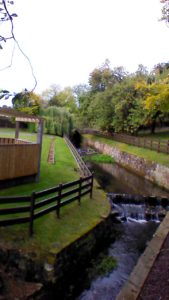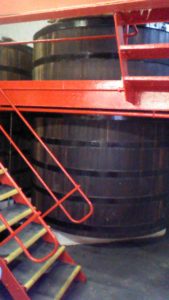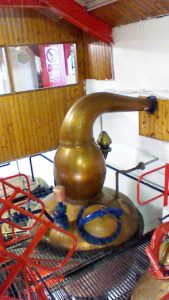This we trip to Scotland has given me pause for thought. I am struggling with the question – what is whisky?
Technically it is an alcoholic spirit beverage made from barley and other cereal grains. But, the bigger issue is how is it made and to what degree is it elevated?
Technically the definition for Whisky in Canada says that aging 3 years in small wood earns one the right to call it a Canadian Whisky. There is nothing that sets any restrictions on ingredients. A Canadian distiller could use barley, wheat, corn, rye, oats…etc…
The generally accepted protocol seems to be for a big commercial distiller in Canada to bring the distillate off a column still at 95% (almost a Vodka-like material) and then blend that base with distillates of other grains that are perhaps less than 95%. After that, it all gets aged in small wood (casks less than 700 liters), which are oak for the most part. Where this column still notion came from, I do not know. What drove the urgency to create a spirit so clean that it only needed 3 years of aging, I do not know. The 3 years in itself seems to hearken back to Canada’s days as a British colony where the Brits set the laws. But the 3 years is simply a minimum. The urgency is then further added to when one realizes that by Canadian law we can actually add up to 9.09% of other stuff (including wine…) and caramel color. Add artificial flavor and the law says only 2 years of aging is needed. So the next time you are having a Canadian whisky – ask yourself what are you drinking. If the label does not explicitly say how old it is…you might be shocked at what is in that libation. Now I understand why 2 years ago when I was at a spirits conference in London, speaker Dominik Roskrow went on a wicked tirade against Canadian whisky makers, whom he regards as a bunch of mad laboratory scientists.
In Scotland, technically 3 years is also required. But, so many of the distillers have stayed true to the old method of distilling using goose-neck pot stills and then aging for 10,12, 15 years and more. Somehow, this artistry got lost when Canada became a nation.
In the USA, the artistry was partly maintained as the USA became its own nation in 1776. US law demands that bourbon, for example, shall come off the still at 80% or less. Then, law further states that a “new” oak cask shall be used. Then law says the maximum alcohol strength in the aging cask shall be 62.5%. Then the law says, age it 4 years minimum or face the embarrassment of posting an age statement on your label. This has served to elevate the status of American bourbons and whisky’s on the word stage.
And now we have the craft distilling revolution unfolding before our eyes. Craft distillers are relying on our lax laws and are calling their whisky products grain mashes, moonshines, spirit drinks. Some have even found a weakness in the law that technically allows one to call it whisky without even aging it. Excise Canada officials are trying hard to get that “horse back into the barn”. What worse, I see craft distillers now throwing oak sticks and chips into a container to give their so-called whisky some color and oak notes in a hurry. Add some toasted oak chips to some clear distillate sometime and count the days until the liquid is brown, to see what I mean…
These craft distillers, in my not so humble opinion, are making PISS IN A BOTTLE. I am growing ever more worried that the craft movement is going to collapse under its own weight. Consumers in this day and age of readily available information via the internet and easy travel opportunities are getting savvy quickly. I fear they are going to turn their back on craft if craft does not move fast to understand the science behind spirits making. As I caution people in the Distillery Workshops, “Betty Crocker has left the building”. In other words, if you think that making spirits is like baking a cake out of a cardboard box, then maybe craft distilling is NOT for you.
I am now seeing a rumbling of sorts coming from at least one of the big boys. Pernod Ricard owns the Wiser’s brand name and their Vice President is Don Livermore. By the way, Dr. Livermore obtained his pH.D. from Heriot Watt where I am currently working on my M.Sc. Dr. Livermore was quoted in a recent edition of Quench magazine as saying he “hates craft”. I say look out! This is a man who understands the science and who has the corporate horsepower to start bringing some uniquely innovative products to market that will take a nasty swipe at the idea of craft.
So craft people, I say the time to bid farewell to PISS IN A BOTTLE has come. It is time to play the long game and start making whisky that is properly nurtured. The French even have an expression for this. They call it ‘elevage’, meaning to raise or nurture. Forget about running to vendors looking for oak chips from old Scotch barrels and old Bourbon barrels. Get off your lazy asses and embrace science. You want some smokiness in a whisky? Buy some smoked barley with a high phenol content and add it to your mash. How much to add? You figure it out. Betty Crocker has left the building. Better yet, build a little cold smoker and smoke your barley with local woods from your area. Want something that tastes like Bourbon? Never mind adding chips and stuff. Figure out a mash that will give you a nice tasting Bourbon. Better yet – read my book called The Recipe. I give you all that you need. In short – start playing the role of the craftsman. That is what craft distilling is all about. It is not about cutting corners and trying to sneak one by the consumer. The customer is still early in his relationship with craft. Based on the number of craft distillery failures I am now starting to see in the USA, I say this relationship is about to go through a rough spell, even here in Canada.
On on this dire note, I have a wee dram of 15 year old cask strength calling my name. If I listen carefully, I think I can hear choirs of angels singing….








